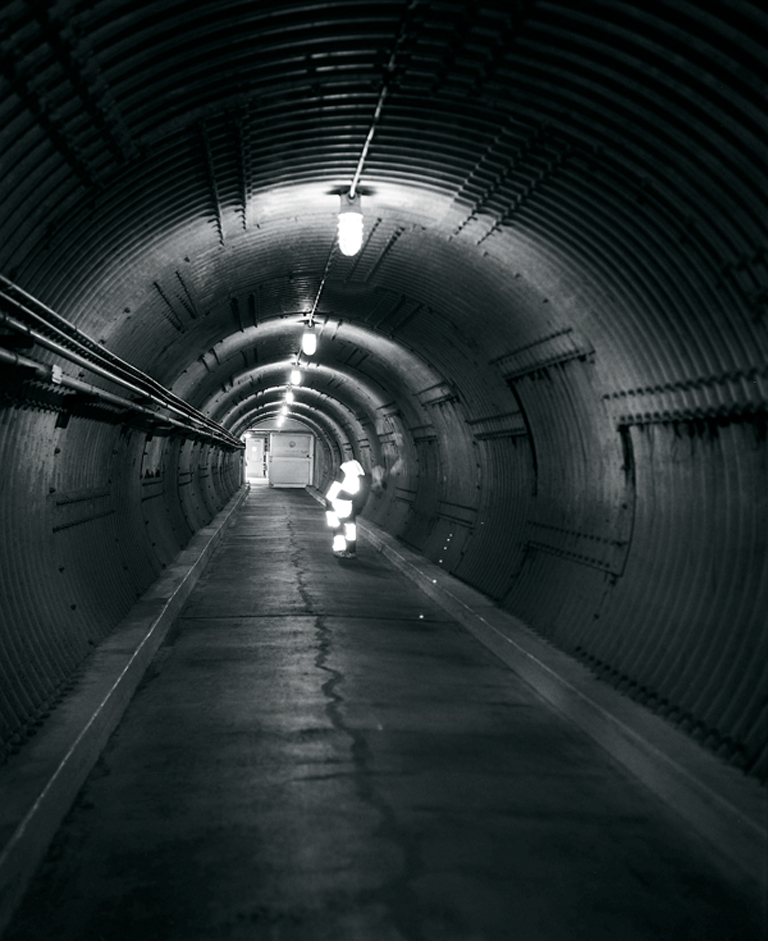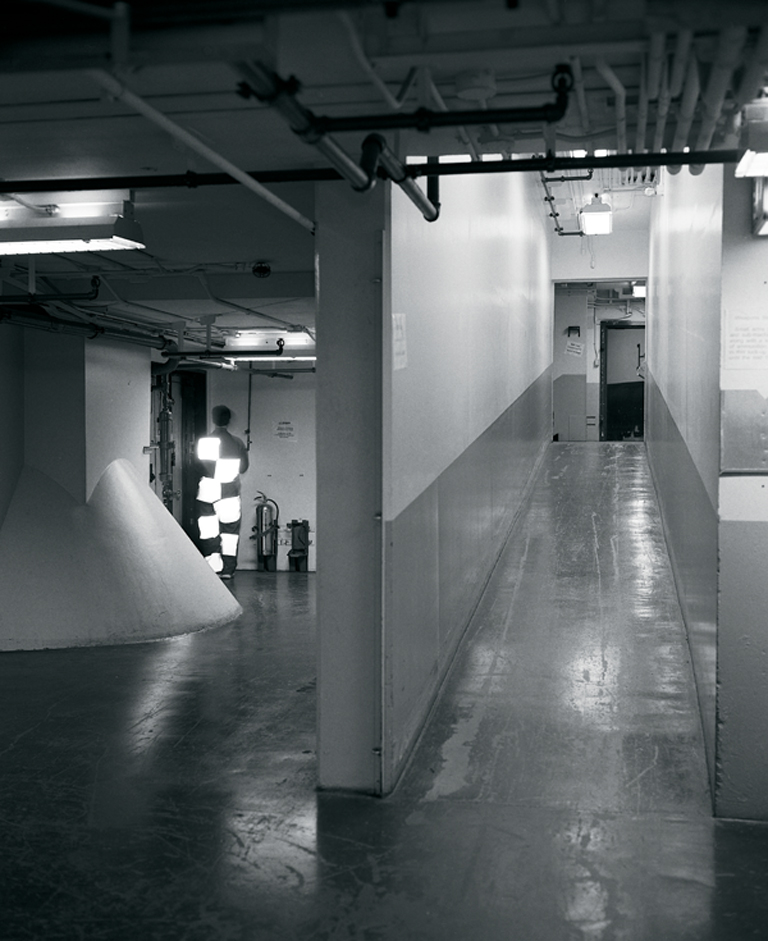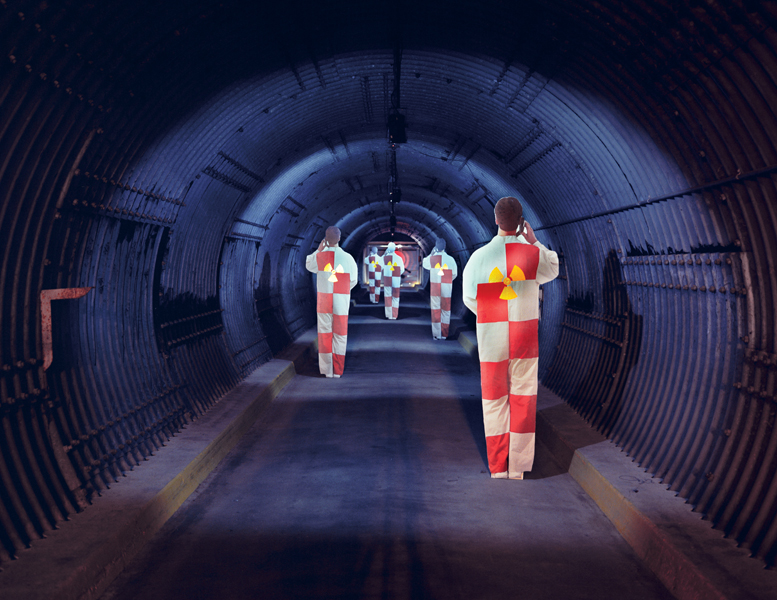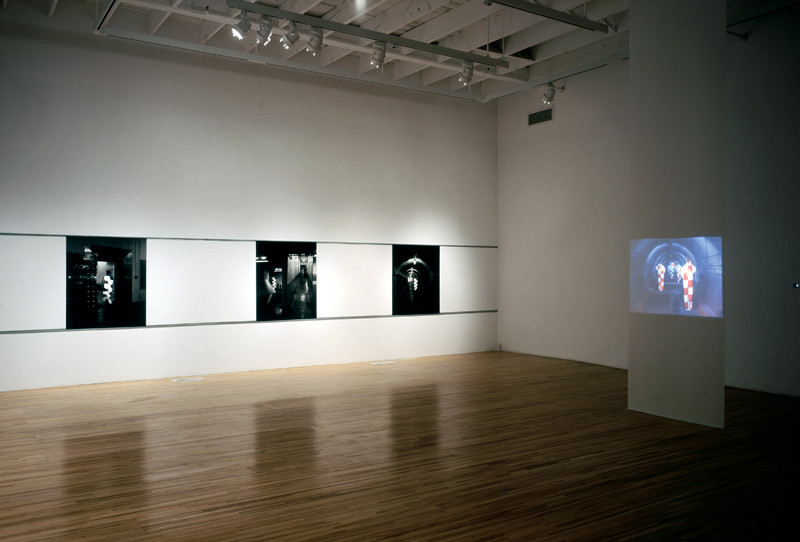[Summer 2005]
In a string of works produced following a site-specific group exhibition in the Canadian government’s once top-secret underground bunker, and now a decommissioned relic of the Cold War, Farley demonstrates his dual strategy of framing spaces in which he appears inside the view, so that each image encapsulates the observer and the observed.
by Johanna Mizgala
A recurring theme in Montreal-based photographer Denis Farley’s work is the relationship between the photographer and his choice of subject matter – in particular, the necessary connection between the body and the landscape.
Recognizing that a natural space is transformed through its framing into something to be consumed as landscape, Farley frequently appears in his photographs, posed from behind and looking into the picture plane. His unexpected presence interrupts the expanse of terrain, making his images speak from a larger language of documentary photography and requiring the viewer to be an active beholder, acutely aware of the process behind the creation.
While Farley is present in his photographs, they are not strictly self-portraits: more importantly than embodying his likeness, the images posit Farley as a trope of his profession. Speaking less about Farley as individual than about his activity as photographer, they are self-conscious gestures, clearly elucidating what he does, what he sees, and – by extension – what he asks the viewer to experience.
Following his participation in Singular Fission, a site-specific group exhibition at the Diefenbunker, Farley produced a series of five black-and-white photographs collectively titled Irradiations (2000–02). The Diefenbunker is a Cold War relic, secretly commissioned by the Canadian government in the late 1950s on the outskirts of Ottawa. The four-storey subterranean facility, designed to provide shelter and workspace for key political figures and military personnel, boasted an Emergency Government Situation Centre, a War Cabinet Room, a fully operational broadcast studio for CBC radio, a Bank of Canada vault, and living accommodations, including a modest suite for the Prime Minister and a detention centre, should anyone living underground require forcible confinement. The Department of National Defence maintained the facility in ready working order until 1994, when budget cuts forced its closure. Considered a national historic site, the decommissioned space was opened to the public as the Canadian Museum of the Cold War.
Farley offers the viewer a privileged view into the facility’s terrain. By his presence within these images, he creates unsettling connections between its past, its intended use, and its current state as a museum. In each photograph, his singular glowing figure garbed in a chequered coverall patrols the lonely corridors like an iridescent ghost. His trajectory is deliberately ambiguous but nonetheless strangely captivating. Is this an invitation or an intrusion? Is he a sentry or our guide? Just as Alice in Wonderland felt compelled to go down the rabbit hole, the viewer is drawn to follow Farley farther and farther into the recesses of a hitherto restricted space.
Farley’s body in the frame, though overtly evident, is nonetheless subtly revealed through his stance in relation to the camera and through his uniform. The repetition of this gesture and his standardized attire render him simultaneously obvious and somewhat anonymous. In these works, Farley’s clothing appears to emit an eerie glow, prompting the viewer to speculate on the Cold War promise of protection from radiation deep inside the fallout shelter.
From his vantage point, Farley invites the viewer to look at the shelter’s interiors with him – or through him, as the case may be. In the same way that the natural world becomes landscape through his conscious act of looking and framing, the bunker’s spaces are transformed for investigation and speculation. Farley positions himself as both the beholder and the beheld, as the observer being observed. As he is working in black and white instead of in colour, as in previous works, the images have an affinity to archival photographs, as though the viewer has stumbled upon secret government documentation of the goings-on underground, and this adds a layer of surreptitious glee that interrupts and layers time.
The sensation of viewing a place so squarely caught between – not quite from its prescribed past and thus not in its intended present – is further heightened by the correlation to the location’s current use. It is now a museum, but it is shown to us here devoid of any human activity except for the solitary roamings of our guide. Farley’s presence within these locales is much more jarring than observing him standing in a landscape, as his very presence here reminds us of the existence of such once top-secret places. Moreover, had the Cold War threats been genuine, spaces such as this would have been our landscape, making the world outside an alien terrain.
In conjunction with the Mois de la photo à Montréal, the Maison de la Culture Côte-des-Neiges will present Denis Farley’s exhibit Irradiations II from September 8 to October 9, 2005.
Denis Farley lives and works in Montreal. His work has been shown in Canada, Europe, and the United States, and is included in the collections of the Montreal Museum of Fine Art, the Fonds National d’Art Contemporain in Paris, the Musée de Charleroi in Brussels, the Musée du Québec in Quebec City, and the Canadian Museum of Contemporary Photography in Ottawa. www.denisfarley.net
Johanna Mizgala is the curator of exhibitions for the Portrait Gallery of Canada, an initiative of Library and Archives Canada. Having worked on a number of contemporary curatorial projects and written extensively on visual art practice, she is a frequent invited speaker and a regular contributor to contemporary art periodicals, including CV ciel variable.










